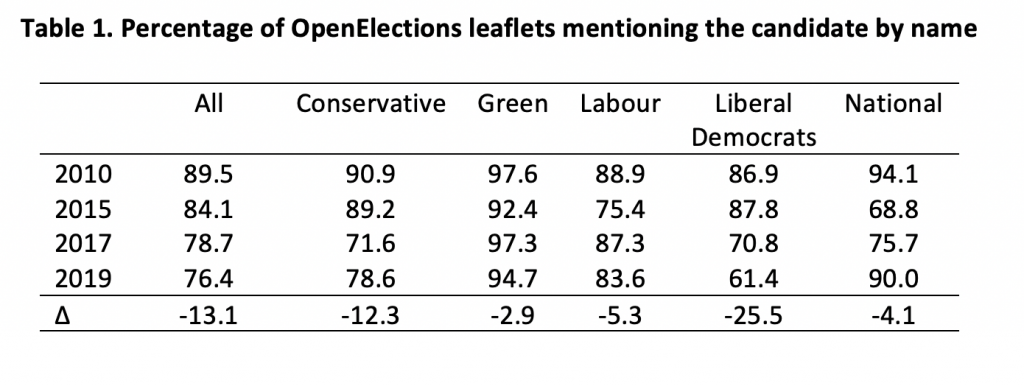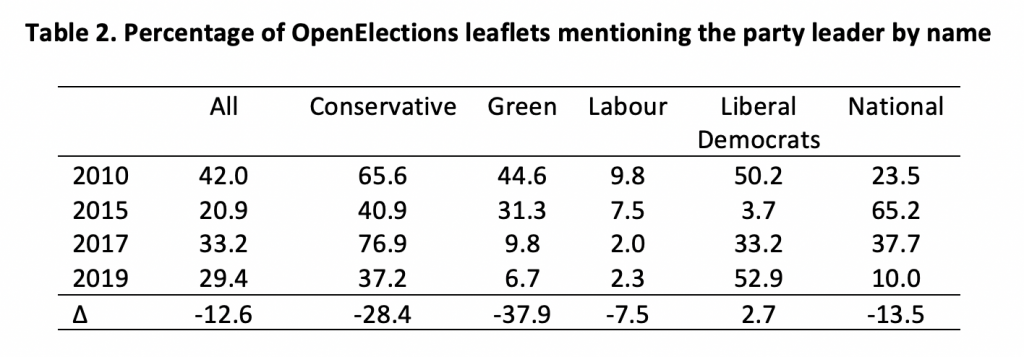
 The personal characteristics of political elites play an important role in British elections. Caitlin Milazzo and Siim Trumm discuss how candidates’ attributes feature in general election leaflets using data from the OpenElections project.
The personal characteristics of political elites play an important role in British elections. Caitlin Milazzo and Siim Trumm discuss how candidates’ attributes feature in general election leaflets using data from the OpenElections project.
The personal attributes of political elites are now a common feature of campaigns, even in systems where parties dominate politics. Britain is no exception. A candidate might emphasise her connections to the local community; perhaps she was born there, it is her place of residence, or her children attend a local school. She might also emphasise her personal traits, such as her occupation or experience as a local councillor, to signal her ability to provide her constituents with competent representation. And we know that these traits matter to voters.
The OpenElections project aims to increase the transparency around what parties and their candidates say during general election campaigns. For the project, we analysed the content of more than 8,600 election leaflets from the last four general elections. With respect to personalisation, they allow us to explore the extent to which leaflets are becoming more personalised over time and how candidates talk about their personal vote-earning attributes in their campaign materials.
Have campaigns become more personalised?
There is widespread consensus that individual politicians feature prominently in British media. However, we know less about personalisation in the campaign leaflets that voters receive. Using data from OpenElections project, we find that, on balance, campaign leaflets ere becoming less personalised over time. Across all parties, we see a 13-point decline in the percentage of leaflets that reference their candidates by name (Table 1). We see this pattern across all parties, though the change is neither linear, nor uniform. The decline in personalisation is greatest for the Liberal Democrats, who have seen a 26-point decline in the percentage of the OpenElections leaflets that mention their candidates by name between 2010 and 2019, while the Green Party has seen only modest changes during this period.
 We see a similar trend when looking at references to party leaders (Table 2), though there is far more variation. Mentions of party leaders have declined quite dramatically for the Conservatives and the Green Party. Labour has experienced more modest drops, although it is worth noting that they have consistently been unlikely to mention their leader during this period.
We see a similar trend when looking at references to party leaders (Table 2), though there is far more variation. Mentions of party leaders have declined quite dramatically for the Conservatives and the Green Party. Labour has experienced more modest drops, although it is worth noting that they have consistently been unlikely to mention their leader during this period.
Taken together, these findings suggest that while the media’s coverage of elections may be increasingly likely to emphasise individuals, on balance, the campaign materials voters received have become less personalised over the last decade.
How do candidates talk about themselves?
The closer a candidate resides to their voters – and the more local they are perceived to be – the greater the electoral payoff. Studies also show that race, ethnicity, and occupation all influence a candidate’s popularity. As part of the OpenElections project, we have undertaken some additional coding of the 2015-2019 leaflets that allows us to explore how candidates talk about their personal attributes. Here, we focus on leaflets distributed by candidates themselves, rather than their party, and we explore the extent to which candidates mention their ties to their local community or their employment, education, or family.
Our analysis suggests that, across all parties and all elections, the most common traits that are emphasised are local ties and employment (Table 3); approximately one third of all the candidate leaflets in our dataset mention these traits. What is striking, however, is the remarkable consistency in how candidates discuss their attributes across parties. While we do see some variation – for example, candidates from the Green Party are significantly more likely to mention their ties to the community than candidates from other parties – the patterns are remarkably consistent across parties.
What is also striking about the extent to which candidate leaflets mention their personal attributes is actually the relative lack of such mentions. We know from research that candidates’ attributes affect their popularity. Yet, most candidates simply do not talk about themselves in their leaflets. In each of the three general elections between 2015-2019, more than half of the candidate leaflets included in the OpenElections dataset had no additional mentions of the candidates’ local ties or other personal attributes, beyond their name.
There is a lot of talk about the personalisation of politics in Britain (and beyond). The story emerging from the general election leaflets, however, suggests that, if anything, these have become less personalised over the last decade.
___________________
About the Authors
 Caitlin Milazzo is Professor of Politics at the University of Nottingham. Her areas of research include electoral behaviour, British politics, and political campaigning.
Caitlin Milazzo is Professor of Politics at the University of Nottingham. Her areas of research include electoral behaviour, British politics, and political campaigning.
 Siim Trumm is Associate Professor at the University of Nottingham. His areas of research include British politics, parliamentary representation, and electoral campaigns.
Siim Trumm is Associate Professor at the University of Nottingham. His areas of research include British politics, parliamentary representation, and electoral campaigns.
Photo by Phil Hearing on Unsplash.










Interesting research. I wonder how much the reduction in the proportion of leaflets featuring candidates’ names is down to parties making greater use of national spending limits and avoiding naming candidates so that the costs of those leaflets don’t have to be apportioned to constituency spending limits.